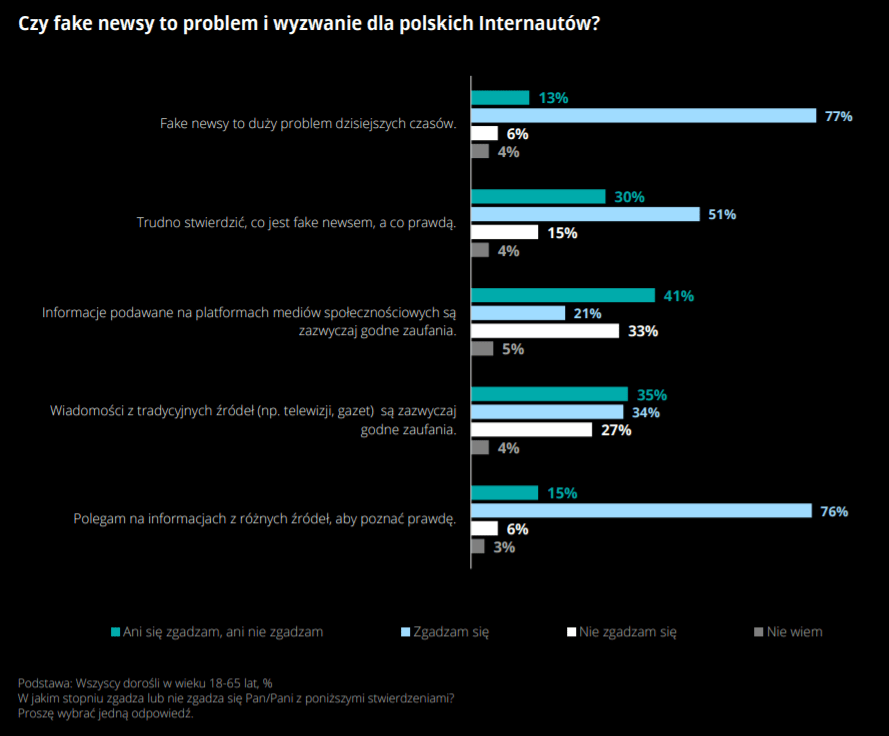Top methods Poles use to follow news and current events:
- 28% - television
- 28% - social media
- 18% - news websites or apps
- 8% - radio
- 10% - other
- 8% - not interested in following news
Given that over a quarter of consumers rely on sources with challenging credibility verification, fake news remains a serious problem. While 77% of respondents acknowledge the issue, 51% admit difficulty in assessing the truthfulness of information.
The high popularity of social media as an information source is concerning, as experts warn it provides an ideal environment for the rapid spread of unverified information. Moreover, fewer social media users find these platforms trustworthy compared to television (21% vs. 34%).
 Source: Digital Consumer Trends 2021, Deloitte
Source: Digital Consumer Trends 2021, DeloitteThree-quarters of respondents claim to verify the origin of the information they receive.
- The highly effective spread of unfounded theories suggests that verification often happens within other social media channels sharing the same content, says Rafał Wojciechowski, senior manager at Deloitte. - One of the biggest challenges for media and regulators should be ensuring effective mechanisms to confirm the accuracy of information.
Social Media Less Popular
The overload of false information prompts only slightly more than one-fifth of Deloitte`s respondents to stop using social media. The most common reason, cited by a third of respondents, is boredom with the platform, especially among older users (39% in the 55-65 age group). One in four mentions spending too much time on social media as a reason to quit.
Interestingly, the youngest users are the most likely to temporarily or permanently quit at least one social media platform - 43% of 18-24-year-olds, compared to just one in five in the 55-65 age group.
- The desire to spend time more meaningfully, distance oneself from polarizing discussions, and improve well-being also drives users away from social media, says Maciej Dakowicz, senior manager at Deloitte Digital. - This trend requires marketers to diversify communication channels to reach different target groups and create valuable content that positively impacts users.
Find the second part of the Digital Consumer Trends 2021 report at:
https://www2.deloitte.com/pl/pl/pages/technology-media-and-telecommunications/articles/Digital-Consumer-Trends-2021-part-2.html
Identifying Fake News
Artificial intelligence is increasingly used to create fake information. Software now exists to manipulate public speeches by politicians. For instance, a video of Barack Obama delivering the same speech at different ages was generated using specialized software. This technology means public appearances by any politician can now be fabricated.
A large-scale example of fake news manipulation was the 2018 Facebook scandal. Cambridge Analytica acquired data from over 50 million Facebook users to create personalized ads influencing voter decisions. This likely impacted the Brexit vote and the U.S. presidential election.
Fake News in Poland and Europe
Three-quarters of Poles encounter fake news or distorted information at least once a week. Only 14% believe this issue does not affect them, according to Kantar Public`s Eurobarometer survey.
60% of digital creators do not verify information before publishing 👇
When asked, "Does the presence of distorted or false information pose a problem in your country?" 84% of Poles responded affirmatively:
- 49% - definitely yes
- 35% - somewhat yes
- 9% - somewhat no
- 3% - definitely no
- 4% - don`t know/no opinion
These results place Poland in line with the EU average (44% - definitely yes, 41% - somewhat yes).
Eurobarometer findings echo a Press Club Polska analysis on trust in media information, showing the highest trust in social news and the lowest in political news:
- social news: trust 68%, distrust 30%
- economic news: trust 57%, distrust 40%
- political news: trust 46%, distrust 49%
According to Press Club Polska, credibility in media is most influenced by presenting independent expert opinions, referencing scientific research, and citing diverse sources, rather than the neutrality of language or source popularity.
COMMERCIAL BREAK
New articles in section Media industry
Advertising market 2025. Poland, Europe and the World
Marcin Grządka
The global advertising market is growing by 8.8% in 2025 and will reach a value of 1.14 trillion dollars. The industry result in Europe records slightly lower dynamics, at the level of 5.8%. In this comparison, Poland performs clearly above the average. We will record an increase of 8.9% this year and a value of 18.56 billion PLN - estimates WPP Media in the annual report "This Year Next Year".
The print media market 2025. Three global trends
Krzysztof Fiedorek
The market value is 359.53 billion dollars, yet the erosion is visible to the naked eye. The decline for newspapers will amount to -2.3 percent. Despite this, print retains strength: it generates 76 percent of subscription revenues and enjoys 82 percent consumer trust. The future of the industry is defined by hybrid strategies and niche specialization.
Journalism in the age of AI. Why people prefer humans over machines
Krzysztof Fiedorek
Only 12% of people accept news created solely by AI, while 62% prefer those written by humans. At the same time, only 19% notice labels indicating the use of artificial intelligence, while younger audiences ask AI to explain the content to them. These are the findings of the Reuters Institute report on artificial intelligence in media.
See articles on a similar topic:
Radio Fanatics. Who Listens for One-Third of the Day?
Bartłomiej Dwornik
One in five listeners now spends over 8 hours daily listening to the radio, according to data from the Radio Track study. Since the beginning of the year, the number of these avid listeners has grown by 300,000.
Gen Z Will Force Brands to Tell the Truth. GWI Report and Forecasts
Krzysztof Fiedorek
They value authenticity and brand transparency, preferring socially engaged companies. Young people see technology as a tool for growth, not just entertainment. In relationships, they prioritize genuine connections despite being highly active online. What do we know about Gen Z, and what does this mean for marketing? And beyond.
Most medical influencer posts on TikTok are FALSE
KFi
Researchers from East Carolina University Health Medical Center analysed 120 TikTok videos tagged with hashtags such as #naturalparenting, #antivaccine, and #holistichealth. The results of their study leave no doubt.
COVID-Skeptics in Media. Dentsu Agency Study
BARD
A significant presence of COVID-skepticism, which downplays the pandemic or focuses on conspiracy theories, accounts for approximately 8% of online content related to the coronavirus. The primary sources of knowledge about COVID-19 and the current situation are the internet, social media, television, and increasingly, family and friends.





























